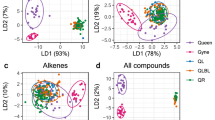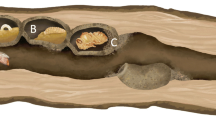Summary
Ontogenetic patterns of volatile compounds identified in Dufour's gland extracts from queens and workers of the primitively eusocial sweat beeLasioglossum malachurum (K.) were compared. Only young unmated queens showed high proportions of isopentenyl esters, while macrocyclic lactones were dominant in old breeding queens, spring queens, and workers. In young queens the relative and absolute amounts of volatiles changed one day after mating. A discriminant analysis revealed significant differences in odor patterns of unmated and mated young queens. The fat body was the largest in young females, while eggs could be recorded only in breeding queens. Possible functions of different odor components in the investigated female groups are discussed.
Similar content being viewed by others
References
Albans, K. R., R. T. Aplin, J. Brehcist, J. F. Moore and C. O'Toole, 1980. Dufour's gland and its role in secretion of nest cell lining in bees of the genusColletes (Hymenoptera: Colletidae).J. Chem. Ecol. 6:549–564.
Ayasse, M., 1987. Die Rolle von Duftstoffen bei der Partnerwahl von Furchenbienen (Hymenoptera: Halictidae).Apidologie 18:335–339.
Ayasse, M., 1990a. Visuelle und olfaktorische Orientierung in der Nestfindung beiLasioglossum malachurum (Hymenoptera: Halictidae).Apidologie 21:349–351.
Ayasse, M., 1990b. Odor based interindividual and nest recognition in the sweat beeLasioglossum malachurum (Hymenoptera: Halictidae). In:Social insects and the environment (G. K. Veeresh, B. Mallik, C. A. Viraktamath, Eds.), (Proc. 11th Int. Congr. IUSSI, Bangalore), Oxford & IBH Publishing, New Delhi, Bombay, Calcutta, pp. 511–512.
Ayasse, M., 1991. Chemische Kommunikation bei der primitiv eusozialen FurchenbieneLasioglossum malachurum (Halictidae): Ontogenese kastenspezifischer Duftstoffbouquets, Paarungs-biologie und Nesterkennung. Doctoral thesis, Tübingen, Germany, 226 pp.
Ayasse, M., R. Leys, P. Pamilo and J. Tengö, 1990a. Kinship in communally nestingAndrena (Hymenoptera: Andrenidae) bees is indicated by composition of Dufour's gland secretions.Biochem. Syst. Ecol. 18:453–460.
Ayasse, M., W. Engels, A. Hefetz, G. Lübke and W. Francke, 1990b. Ontogenetic patterns in amounts and proportions of Dufour's gland volatile secretions in virgin and nesting queens ofLasioglossum malachurum (Hymenoptera: Halictidae).Z. Naturforsch. 45c:709–714.
Ayasse, M., G. Lübke and W. Francke, 1991. Alters- und kastenspezifische Duftstoffmuster bei der Fortpflanzung der FurchenbieneLasioglossum malachurum (Hymenoptera: Halictidae).Verh. Dtsch. Zool. Ges. 84:386–387.
Backhaus, K., B. Erichson, W. Flinke, Chr. Schuchard-Ficher and R. Weiber, 1987.Multivariate Analysemethoden. Springer-Verlag, New York, 404 pp.
Barrows, E. M., 1975. Individually distinctive odors in an invertebrate.Behav. Biol. 15:57–64.
Barrows, E. M., W. J. Bell and C. D. Michener, 1975. Individual odor differences and their social functions in insects.Proc. Nat. Acad. Sci. USA 72:2824–2828.
Batra, S. W. T., 1966. The life cycle and behavior of the primitively social beeLasioglossum zephyrum.Univ. Kansas Sci. Bull. 10:359–423.
Bauer, F., 1986.Datenanalyse mit SPSS. Springer Verlag, New York, 256 pp.
Bell, W. J., 1974. Recognition of resident and non-resident individuals in intraspecific nest defense of a primitively eusocial halictine bee.J. Comp. Physiol. 93:195–202.
Bonavita-Cougourdan, A., J. L. Clément and C. Lange, 1987. Nestmate recognition: the role of cuticular hydrocarbons in the antCamponotus vagus Scop.J. Entomol. Sci. 22:1–10.
Brooks, R. W. and J. H. Cane, 1984. Origin and chemistry of the secreted nest entrance lining ofHalictus hesperus (Hymenoptera: Apoidae).J. Kansas Entomol. Soc. 57:161–165.
Brosius, G., 1989.SPSS, PC+ advanced statistics and tables. MacGraw-Hill Book Company, Hamburg, 581 pp.
Cane, J. H., 1981. Dufour's gland secretion in the cell linings of bees (Hymenoptera: Apoidae).J. Chem. Ecol. 7:403–410.
Chino, H., 1985. Lipid transport: biochemistry of hemolymph lipophorin. In:Comprehensive insect physiology, biochemistry, and pharmacology. Volume 10 (G. A. Kerkut and L. I. Gilbert, Eds.), Pergamon Press, Oxford, pp. 115–135.
Duffield, R. M., W. E. LaBerge, J. H. Cane and J. W. Wheeler, 1982. Exocrine secretions of bees. IV. Macrocyclic lactones and isopentenyl esters in the Dufour's gland secretions ofNomia bees (Hymenoptera: Halictidae).J. Chem. Ecol. 8:534–543.
Duffield, R. M., J. W. Wheeler and G. C. Eickwort, 1984. Sociochemicals of bees. In:Chemical ecology of insects (W. J. Bell and R. T. Cardé, Eds.), Chapman and Hall Ltd. London, New York, pp. 387–428.
Engels, E. and W. Engels, 1988. Age-dependent queen attractiveness for drones and mating in the stingless bee,Scaptotrigona postica.J. Apicult. Res. 27:3–8.
Francke, W., W. Schröder, G. Bergström and J. Tengö, 1984. Esters in the volatile secretion of bees.Nova Acta Regiae Soc. Sci. Upsal. Ser. V:C, 3:127–136.
Getz, W. M. and R. E. Page, J, 1991. Chemosensory kin-communication systems and kin recognition in honey bees.Ethology 87:298–315.
Greenberg, L., 1979. Genetic component of bee odor in kin recognition.Science 206:1095–1097.
Hefetz, A., 1987. The role of Dufour's gland secretions in bees.Physiol. Entomol. 12:243–253.
Hefetz, A., 1990. Individual badges and specific messages in multicomponent pheromones of bees (Hymenoptera: Apidae).Entomol. Gener. 15:103–113.
Hefetz, A., M. S. Blum, G. C. Eickwort and J. W. Wheeler, 1978. Chemistry of the Dufour's gland secretion of halictine bees.Comp. Biochem. Physiol. 61B:129–132.
Hefetz, A., H. M. Fales and S. W. T. Batra, 1979. Natural polyesters: Dufour's gland macrocyclic lactones form brood cell laminesters inColletes bees.Science 204:415–417.
Hefetz, A., G. Bergström and J. Tengö, 1986. Species, individual and kin specific blends in Dufour's gland secretions of halictine bees — Chemical evidence.J. Chem. Ecol. 12:197–208.
Hefetz, A. and D. Graur, 1988. The significance of multicomponent pheromones in denoting specific compositions.Biochem. Syst. Ecol. 16:551–566.
Hölldobler, B. and C. D. Michener, 1980. Mechanisms of identification and discrimination in social hymenoptera. In:Evolution of social behaviour: Hypotheses and empirical tests, Dahlem Konferenzen, (H. Markl, Ed.), Verlag Chemie GmbH, Weinheim, pp. 35–58.
Hölldobler, B. and N. F. Carlin, 1987. Anonymity and specificity in the chemical communication signals of social insects.J. Comp. Physiol. A. 161:567–581.
Howard, R. W., C. A. McDaniel, D. R. Nelson, G. J. Blomquist, L. T. Gelbaum and L. H. Zalkow, 1982. Cuticular hydrocarbons ofReticulitermes virginicus (Banks) and their role as potential species- and caste-recognition cues.J. Chem. Ecol. 8:1227–1239.
Johansson, I., B. G. Svensson, J. Tengö and G. Bergström, 1982. Systematic relationship of halictine bees based on the pattern of macrocyclic lactones in the Dufour's gland secretion.Insect Biochem. 72:161–170.
Keeley, L. L., 1985. Physiology and biochemistry of the fat body. In:Comprehensive insect physiology, biochemistry, and pharmacology, Volume 3, (G. A. Kerkut and L. I. Gilbert, Eds.), Pergamon Press, Oxford, pp. 211–248.
Kukuk, P. F., M. D. Breed, A. Sobti and W. J. Bell, 1977. The contributions of kinship and conditioning to nest recognition in a primitively eusocial bee,Lasioglossum zephyrum (Hymenoptera: Halictidae).Behav. Ecol. Sociobiol. 2:319–327.
Lello de, E., 1971. Adexnal glands of the sting apparatus of bees: Anatomy and histology. II. (Hymenoptera: Halictidae).J. Kansas Entomol. Soc. 44:14–20.
Lewis, T., 1984. The elements and frontiers of insect communication. In:Insect communication (T. Lewis, Ed.), Academic Press, London, pp. 1–27.
Mazomenos, B. E., 1984. Effect of age and mating on pheromone production in the female olive fruit fly,Dacus oleae (Gmel).J. Insect Physiol. 30:765–769.
Michener, C. D., 1974.The social behavior of the bees. Harvard University Press, Cambridge, Mass. 404 pp.
Michener, C. D., 1990. Reproduction and castes in social halictine bees. In:Social insects, An evolutionary approach to castes and reproduction (W. Engels, Ed.), Springer-Verlag, Berlin, Heidelberg, pp. 77–121.
Michener, C. D. and B. H. Smith, 1987. Kin recognition in primitively eusocial insects. In:Kin recognition in animals (D. J. C. Fletcher and C. D. Michener, Eds.), John Wiley & Sons, Ltd. Chichester, England, pp. 209–242.
Norden, B., S. W. T. Batra, H. M. Fales, A. Hefetz and G. J. Shaw, 1980.Anthophora bees: unusual glycerides from maternal Dufour's glands serve as larval food and cell lining.Science 207:1095–1097.
Norusis, M. J., 1986a.SPSS/PS +: SPSS for the IBM PC/XT/AT. SPSS inc., Chicago.
Norusis, M. J., 1986b.SPSS/PC + Advanced Statistics for the IBM PC/XT/AT. SPSS inc., Chicago.
Nowbahari, E., A. Lenoir, J. L. Clément, C. Lange, A. G. Bagneres and C. Joulie, 1990. Individual, geographical and experimental variation of cuticular hydrocarbons of the antCataglyphis cursor (Hymenoptera: Formicidae): Their use in nest and subspecies recognition.Biochem. Syst. Ecol. 18:63–73.
Packer, L. and G. Knerer, 1985. Social evolution and its correlates in bees of the subgenusEvylaeus (Hymenoptera: Halictidae).Behav. Ecol. Sociobiol 17:143–149.
Sakagami, S. F., 1974. Sozialstruktur und Polymorphismus bei Furchen- und Schmalbienen. In:Sozialpolymorphismus bei Insekten (G. H. Schmidt, Ed.), Wissenschaftliche Verlagsgesellschaft mBH, Stuttgart, pp. 257–293.
Shimron, O., A. Hefetz and J. Tengö, 1985. Structural and communicative functions of Dufour's gland secretion inEucerapalestinae (Hymenoptera: Anthophoridae).Insect Biochem. 15:635–638.
Smith, B. H., 1983. Recognition of female kin by male bees through olfactory signals.Proc. Natl. Acad. Sci. USA 80:4551–4553.
Smith, B. H. and M. Ayasse, 1987. Kin-based male mating preferences in two species of halictine bees.Behav. Ecol. Sociobiol. 20:313–318.
Smith, B. H. and J. W. Wenzel, 1988. Pheromonal covariation and kinship in social beeLasioglossum zephyrum (Hymenoptera: Halictidae).J. Chem. Ecol. 14:87–94.
Smith, B. H., R. G. Carlson and J. Frazier, 1985. Identification and bioassay of macrocyclic lactone sex pheromones of halictine beeLasioglossum zephyrum.J. Chem. Ecol. 11:1447–1456.
Tengö, J., M. Sick, M. Ayasse, W. Engels, B. G. Svensson, G. Lübke and W. Francke, 1992. Species specificity of Dufour's gland morphology and volatile secretions in kleptoparasiticSphecodes bees (Hymenoptera: Halictidae).Biochem. Syst. Ecol. 20(4):351–362.
Wcislo, W. T., 1987. The role of learning in the mating biology of a sweat beeLasioglossum zephyrum (Hymenoptera: Halictidae).Behav. Ecol. Sociobiol. 20:179–185.
Westrich, P., 1989.Die Wildbienen Baden-Württembergs I, II, Eugen Ulmer Verlag, Stuttgart, 972 pp.
Author information
Authors and Affiliations
Rights and permissions
About this article
Cite this article
Ayasse, M., Engels, W., Hefetz, A. et al. Ontogenetic patterns of volatiles identified in Dufour's gland extracts from queens and workers of the primitively eusocial halictine bee,Lasioglossum malachmum (Hymenoptera: Halictidae). Ins. Soc 40, 41–58 (1993). https://doi.org/10.1007/BF01338831
Received:
Revised:
Accepted:
Issue Date:
DOI: https://doi.org/10.1007/BF01338831




